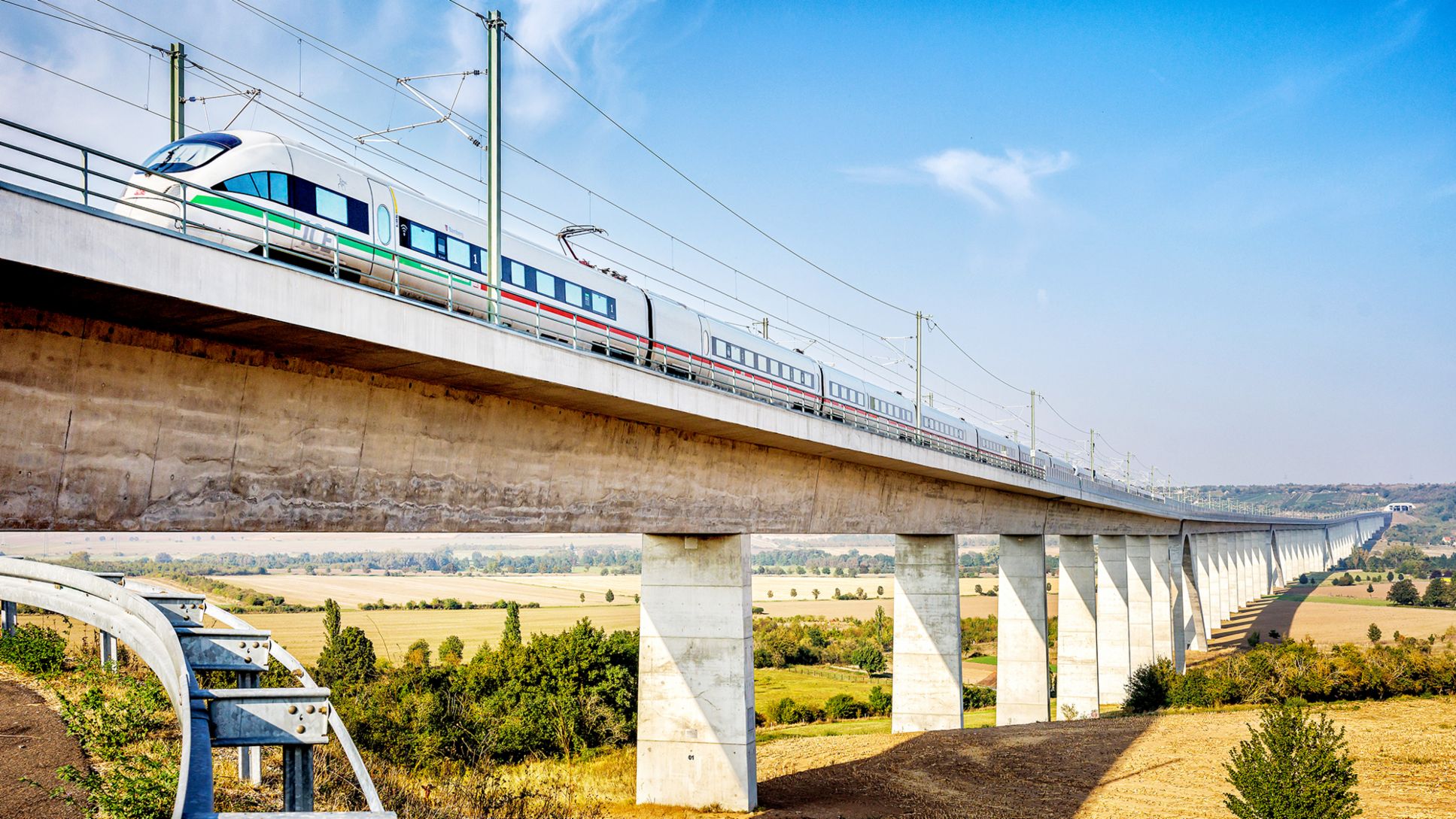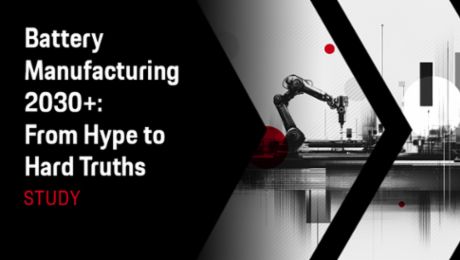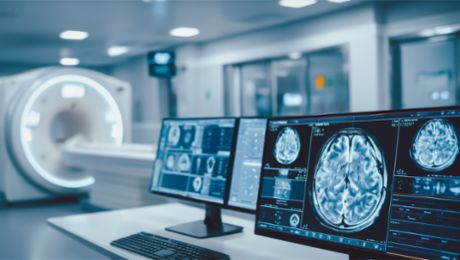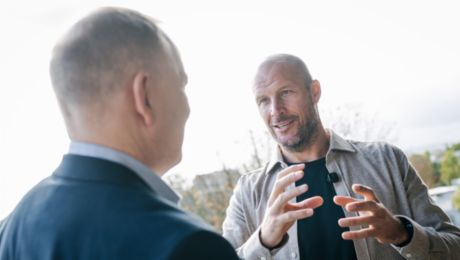More people than ever before are traveling by rail in Germany. Freight transport, too, is booming in this central European transit country. The German Federal Ministry for Transport estimates that by 2040, passenger rail traffic will increase by 8 percent. And freight traffic by 35 percent. Passengers and commercial freight customers alike expect punctual and reliable service both day and night. And that requires one thing above all: “freie Bahn” — which means both unobstructed train tracks and unimpeded progress in general. In other words, a rail infrastructure that is sufficiently dimensioned and resistant to failure. For years, however, the network in Germany has been shrinking. And many of its remaining tracks and shunts need repairs. Too few of the signal towers and systems are state of the art. Because of this overall situation, lines are overcrowded and service can be delayed due to technical problems and corrective maintenance.
The German government is investing more in rail transport now than in the past. The network is not shrinking any further. Yet expansion and new construction projects are not meeting demand in either their extent or pace. For all the critique they face, rail companies do not have it easy. Marc Zacherl, Senior Partner and Global Lead Transportation at the Porsche Consulting management consultancy, is convinced that “greater stability when planning infrastructure projects and more reliability in the funding for longer-term future investments” would help structure rail services to meet demand. In short, the rail system needs greater entrepreneurial scope in order to develop more freely. And planning risks need to be reduced in order not to function like bumper blocks on German rail lines.
One of the main problems is funding. And this depends on the owner of the rail system, namely the German state. In 2024, the Federal Republic of Germany invested more than 16 billion euros in rail infrastructure — nearly twice as much as it did five years ago. However, the most important project, which is a general refurbishment of the 40 most crucial rail corridors by 2030, is not yet fully funded. Of the requisite 45 billion euros, only 27 billion have been released by the owner. A funding shortage is expected to arise by late 2027.
Critics claim that funding for the rail system is piecemeal in nature. Instead of being able to confirm long-term projects, the rail company Deutsche Bahn anxiously waits to see whether new funding is approved from year to year. When the federal budget is tight, money only trickles in. Or, when a new government is formed, it can set new priorities and dispense with previous ones. These changes in course make it hard to plan long-term projects. The situation is made all the more complex by the fact that there are nearly 200 different funding pots for infrastructure projects. How much money for which projects will come from which pots? Experts have therefore long been calling for one infrastructure fund that also draws on private sources of capital, that consolidates finances, and that can be used over decades. This would give more room to maneuver.
Uncertain planning also affects business partners, service providers, locomotive and carmakers, and contractors for large-scale construction projects. It also affects cargo companies that seek to use environmentally friendly rail services. Porsche Consulting wanted to know the crucial concerns and ideas of companies and organizations that work closely together with the rail system, and spoke with five leading experts.
“We need a clear, transparent framework” Jens Sprotte, Vice President Marketing and Strategy, Alstom

Alstom, a producer of rail vehicles and systems, is one of Deutsche Bahn’s most important suppliers. Jens Sprotte, Vice President Marketing and Strategy for the French corporation, praises the “good planning security” that has marked his company’s joint projects with Deutsche Bahn in the past. The federal tendering system ensures that his company knows which rail lines will be built when, and what types of rolling stock will be needed. “Those are clear and transparent framework conditions,” he notes. “Recently, however, these frameworks have dissipated as a result of budget conflicts and shifting policy directives.” He gives the following example: Alstom was in a good position to provide suitable high-performance rail vehicles in response to a call for tenders from one of the German states, but the project was delayed for five years “because the commissioning authority for the local public transportation system is unsure of future conditions.” The consequence for Alstom and its customer: “We can’t bring a new generation of rolling stock onto the market, and the commissioning authority cannot expand the system’s capacity or passenger convenience.”
As Sprotte emphasizes, the rail system’s problems are not primarily a matter of budget concerns but rather of short-term horizons. “What we need is a transport master plan that brings in all the players, connects individual transport companies, and rests on multiple pillars of stable long-term funding.” In addition, German policymakers need to ask themselves what direction they want the country to take. Especially with respect to innovations. “Contracts in our country are awarded solely on the basis of price about 80 or 90 percent of the time, whereas Switzerland and many northern countries focus more on factors like energy efficiency and innovation,” observes Sprotte. “We, too, should be attaching considerably more importance to technological developments in order to promote sustainability. We also have to go with the fact that as a high-price country, we’re not going to succeed against international competitors by winning price wars.”
“Stop removing freight tracks!” Dr. Maximilian Altmann, CEO, ARS Altmann AG

ARS Altmann AG, one of Europe’s leading forwarding and logistics companies for finished vehicles, transports around 1.7 million vehicles annually by rail and road from production sites such as Wolfsburg and Ingolstadt to loading stations such as Bremerhaven and Ravenna. The support centers for this asset-heavy company provide the full range of automotive-related services. ARS-Altmann’s own rail company, with a fleet of around 3,500 closed and open wagons, transports vehicles on full trains. Rail is the preferred means of long-distance transport for automobiles, according to CEO Dr. Maximilian Altmann, because freight cars are very secure and do not require any complex terminal infrastructure. “For the same number of cars I can carry on one train, I would need at least 35 trucks on the road,” he adds. There are yet more reasons in favor of rail transport: “I thereby also lower carbon emissions and the risk of damage when loading and unloading.”
This Bavarian corporation currently uses trains for around 60 percent of its transport volume. What would need to happen for ARS Altmann to shift even more of its loads onto trains and thereby lessen road traffic? “In addition to planning security, which plays an enormous role, several low-threshold measures would also help,” says Dr. Altmann. One example would be to stop dismantling freight tracks. With passenger and freight trains using the same lines in Germany, the latter occupy holding tracks when high-speed passenger trains overtake them. As Altmann explains, “Hundreds of kilometers of these parking tracks are currently being dismantled to make room for other rail infrastructure measures. Removing these tracks will mean reducing the level of freight transport — which should not be reduced, however, but rather expanded. The same applies to the infrastructure around car production sites such as Munich, which is also being dismantled. What good is the Brenner Base Tunnel, for instance, when places like Munich don’t have the space for trains to line up?”
“More high-quality and cost-efficient solutions” Stefan Bögl, CEO, Max Bögl Group

Rail infrastructure projects account for a good 10 percent of the Max Bögl Group’s total turnover of 2.7 billion euros. A family company based in Sengenthal in the Upper Palatinate region of Bavaria that employs around 6,500 people at 40 sites, it builds rail bridges and tunnels. It is involved in large-scale projects such as the Fehmarn Belt fixed link in the Baltic Sea and “Stuttgart 21” in the south of Germany. “We see several approaches to improving efficiency in rail construction projects and speeding up their implementation,” says CEO Stefan Bögl. “Earlier inclusion in the planning process can lower costs, coordinate scheduling more reliably, and enable consideration of alternative production and construction options. In addition, we’ve developed innovations that offer high-quality and cost-efficient solutions. With our hybrid railway bridges, for example, structures can be replaced with just one weekend of closure. And greater standardization for bridges would accelerate planning and construction processes and improve economic efficiency.”
The CEO of this construction, technology, and service company is also convinced that “more functional tender processes would make it easier for the construction industry to develop new customized ideas.” In so doing, the industry could incorporate insights and best practices from other projects. “The resulting savings would give contracting authorities greater flexibility in their budgets and help achieve project goals more efficiently.” Financial security is an extremely important point, Bögl adds. In his experience, uncertainty often leads to delays, which then mean higher prices. “Continuous project planning and implementation” are the prerequisites for efficient overall project completion. He also sees considerable potential in alternative means of transport such as magnetic levitation systems. Major advantages of this technology include lower levels of wear and emissions. The Max Bögl Group can develop and provide a turnkey mobility solution of this type with low life cycle costs.
“Switzerland sets a good example” Dr. Heike van Hoorn, CEO, German Transport Forum (DVF)

The German Transport Forum (Deutsches Verkehrsforum, or DVF) is a Berlin-based trade association with 170 member companies from different transport sectors. For years now, it has been calling for more funding for Deutsche Bahn. This year, federal, state, and local governments have provided 16.4 billion euros for rail infrastructure. Not enough, says DVF chief executive officer Dr. Heike van Hoorn. “For one thing rail in Germany has an investment backlog of 92 billion euros that needs to be addressed, and the nearly 30 percent rise in construction costs since 2022 are eating up the additional funding. On top of that, we don’t just want to maintain the rail system but also need to refurbish, modernize, and expand it.” Van Hoorn notes that still only around 60 percent of the track network is electrified. This should reach 75 percent by 2030. Moreover, digitalization is urgently needed. That needs money.
Asked where the money for these gargantuan tasks should come from, the DVF executive reiterates a proposal her organization has made several times: “We favor a fund-based model like the one in Switzerland, which draws on multiple sources including the federal and cantonal governments, plus revenues from taxes on goods and mineral oil. This provides a stable source of funding for rail infrastructure over multiple years independently of annual federal budgets.” A new funding concept would need to fulfill three main criteria, she explains. “We need a long-term funding framework, not new negotiations every year based on fluctuating budget levels. Then we need reliability, in the form of a fund or special set of assets. And finally, detailed coordination is needed between the funding model and the plans for maintenance, expansion, and modernization.”
“More space for entrepreneurship” Marc Zacherl, Senior Partner and Global Lead Transportation, Porsche Consulting

What should European rail transport look like in 15 years? How much infrastructure is needed if passenger volumes are to double, for example? And how can this be funded on a stable basis? According to Marc Zacherl, Senior Partner and Global Lead Transportation at Porsche Consulting, these questions have to be answered before Deutsche Bahn — owned by the German government — can take concrete steps. “A master plan, which will give the system more planning security, needs to be based much more strongly on entrepreneurial needs instead of the political will for structural support.” As one example, Zacherl brings up the approximately 13,000 kilometers of burdened and overburdened rail lines which are “in the last act.” Digitalization is especially urgent here if the goal of doubling passenger volumes by 2030 is to be achieved. “It needs to be done right now, not by 2050.” According to the Porsche consultant, “The signaling systems installed in this infrastructure will enable up to a 20 percent increase in line capacity while also improving on-time performance.”
Zacherl’s second pillar consists of ensuring “medium-term funding stability.” Austria, which started a six-year rolling planning process in 2003, can serve as an example. Within the current period, funding for its rail system is stable until 2029. Zacherl praises the five-year stabilization proposals from Germany’s Rail Acceleration Commission, but says “they now have to be promptly adopted.” As for the funding itself, not only tax money should be used, which involves both state and municipal actors whose interests can often diverge, but also private sources of capital. As he explains, “We can expand our horizons considerably by incorporating public-private partnerships.” He recommends decoupling plans for infrastructure projects such as new rail lines completely from annual budget discussions. Fewer political considerations, and more space for entrepreneurship. “And finally, the complexity in the funding system must be significantly reduced, in order to clear the track for trains.”
Info
Text first published in Porsche Consulting Magazine.





